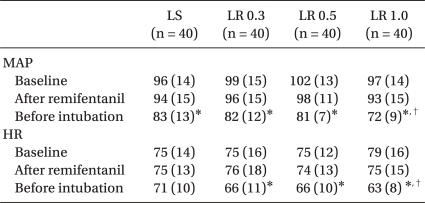1. Bennett SN, McNeil MM, Bland LA, Arduino MJ, Villarino ME, Perrotta DM, et al. Postoperative infections traced to contamination of an intravenous anesthetic, propofol. N Engl J Med. 1995; 333:147–154. PMID:
7791816.

2. Park JW, Park ES, Chi SC, Kil HY, Lee KH. The effect of lidocaine on the globule size distribution of propofol emulsions. Anesth Analg. 2003; 97:769–771. PMID:
12933399.

3. Devlin JW, Lau AK, Tanios MA. Propofol-associated hypertriglyceridemia and pancreatitis in the intensive care unit: an analysis of frequency and risk factors. Pharmacotherapy. 2005; 25:1348–1352. PMID:
16185179.

4. Yamakage M, Iwasaki S, Satoh J, Namiki A. Changes in concentrations of free propofol by modification of the solution. Anesth Analg. 2005; 101:385–388. PMID:
16037149.

5. Baker MT, Naguib M. Propofol: the challenges of formulation. Anesthesiology. 2005; 103:860–876. PMID:
16192780.
6. Kim KM, Choi BM, Park SW, Lee SH, Christensen LV, Zhou J, et al. Pharmacokinetics and pharmacodynamics of propofol microemulsion and lipid emulsion after an intravenous bolus and variable rate infusion. Anesthesiology. 2007; 106:924–934. PMID:
17457123.

7. Jung JA, Choi BM, Cho SH, Choe SM, Ghim JL, Lee HM, et al. Effectiveness, safety, and pharmacokinetic and pharmacodynamic characteristics of microemulsion propofol in patients undergoing elective surgery under total intravenous anaesthesia. Br J Anaesth. 2010; 104:563–576. PMID:
20299348.
8. Sim JY, Lee SH, Park DY, Jung JA, Ki KH, Lee DH, et al. Pain on injection with microemulsion propofol. Br J Clin Pharmacol. 2009; 67:316–325. PMID:
19220277.

9. Fragen RJ, de Grood PM, Robertson EN, Booij LH, Crul JF. Effects of premedication on diprivan induction. Br J Anaesth. 1982; 54:913–916. PMID:
6981419.
10. McCrirrick A, Hunter S. Pain on injection of propofol: the effect of injectate temperature. Anaesthesia. 1990; 45:443–444. PMID:
2200300.

11. Stokes DN, Robson N, Hutton P. Effect of diluting propofol on the incidence of pain on injection and venous sequelae. Br J Anaesth. 1989; 62:202–203. PMID:
2784320.

12. Saadawy I, Ertok E, Boker A. Painless injection of propofol: pretreatment with ketamine vs thiopental, meperidine, and lidocaine. Middle East J Anesthesiol. 2007; 19:631–644. PMID:
18044291.
13. Gehan G, Karoubi P, Quinet F, Leroy A, Rathat C, Pourriat JL. Optimal dose of lignocaine for preventing pain on injection of propofol. Br J Anaesth. 1991; 66:324–326. PMID:
2015149.

14. Ambesh SP, Dubey PK, Sinha PK. Ondansetron pretreatment to alleviate pain on propofol injection: a randomized, controlled, double-blinded study. Anesth Analg. 1999; 89:197–199. PMID:
10389803.
15. Iyilikci L, Balkan BK, Gökel E, Günerli A, Ellidokuz H. The effects of alfentanil or remifentanil pretreatment on propofol injection pain. J Clin Anesth. 2004; 16:499–502. PMID:
15590252.

16. Basaranoglu G, Erden V, Delatioglu H, Saitoglu L. Reduction of pain on injection of propofol using meperidine and remifentanil. Eur J Anaesthesiol. 2005; 22:890–892. PMID:
16225729.

17. Aouad MT, Siddik-Sayyid SM, Al-Alami AA, Baraka AS. Multimodal analgesia to prevent propofol-induced pain: pretreatment with remifentanil and lidocaine versus remifentanil or lidocaine alone. Anesth Analg. 2007; 104:1540–1544. PMID:
17513655.

18. Kwak KH, Ha J, Kim Y, Jeon Y. Efficacy of combination intravenous lidocaine and dexamethasone on propofol injection pain: a randomized, double-blind, prospective study in adult Korean surgical patients. Clin Ther. 2008; 30:1113–1119. PMID:
18640467.

19. Fujii Y, Nakayama M. Prevention of pain due to injection of propofol with IV administration of lidocaine 40 mg + metoclopramide 2.5, 5, or 10 mg or saline: a randomized, double-blind study in Japanese adult surgical patients. Clin Ther. 2007; 29:856–861. PMID:
17697904.
20. Han YK, Jeong CW, Lee HG. Pain reduction on injection of microemulsion propofol via combination of remifentanil and lidocaine. Korean J Anesthesiol. 2010; 58:435–439. PMID:
20532050.

21. Hong SW, Kwak KH. The effects of different doses of remifentanil on propofol injection pain: a placebo controlled comparison of ketamine. Korean J Anesthesiol. 2006; 51:302–307.

22. Macario A, Weinger M, Truong P, Lee M. Which clinical anesthesia outcomes are both common and important to avoid? The perspective of a panel of expert anesthesiologists. Anesth Analg. 1999; 88:1085–1091. PMID:
10320175.

23. Scott RP, Saunders DA, Norman J. Propofol: clinical strategies for preventing the pain of injection. Anaesthesia. 1988; 43:492–494. PMID:
3261547.

24. Klement W, Arndt JO. Pain on injection of propofol: effects of concentration and diluent. Br J Anaesth. 1991; 67:281–284. PMID:
1911014.

25. Kang HJ, Kwon MY, Choi BM, Koo MS, Jang YJ, Lee MA. Clinical factors affecting the pain on injection of propofol. Korean J Anesthesiol. 2010; 58:239–243. PMID:
20498771.

26. Hanci V, Ayoğlu H, Yilmaz M, Yurtlu S, Okyay RD, Erdoğan G, et al. Effect of menstrual cycle on the injection pain due to propofol. Eur J Anaesthesiol. 2010; 27:425–427. PMID:
20216071.
27. Larsen B, Beerhalter U, Biedler A, Brandt A, Doege F, Brün K, et al. Less pain on injection by a new formulation of propofol? A comparison with propofol LCT. Anaesthesist. 2001; 50:842–845. PMID:
11760478.
28. Iwama H, Nakane M, Ohmori S, Kaneko T, Kato M, Watanabe K, et al. Nafamostat mesilate, a kallikrein inhibitor, prevents pain on injection with propofol. Br J Anaesth. 1998; 81:963–964. PMID:
10211027.

29. Eriksson M, Englesson S, Niklasson F, Hartvig P. Effect of lignocaine and pH on propofol-induced pain. Br J Anaesth. 1997; 78:502–506. PMID:
9175962.
30. Wrench IJ, Girling KJ, Hobbs GJ. Alfentanil-mediated analgesia during propofol injection: no evidence for a peripheral action. Br J Anaesth. 1996; 77:162–164. PMID:
8881618.

31. Pang WW, Mok MS, Huang S, Hwang MH. The analgesic effect of fentanyl, morphine, meperidine, and lidocaine in the peripheral veins: a comparative study. Anesth Analg. 1998; 86:382–386. PMID:
9459253.
32. Kwak K, Kim J, Park S, Lim D, Kim S, Baek W, et al. Reduction of pain on injection of propofol: combination of pretreatment of remifentanil and premixture of lidocaine with propofol. Eur J Anaesthesiol. 2007; 24:746–750. PMID:
17261216.








 PDF
PDF Citation
Citation Print
Print


 XML Download
XML Download